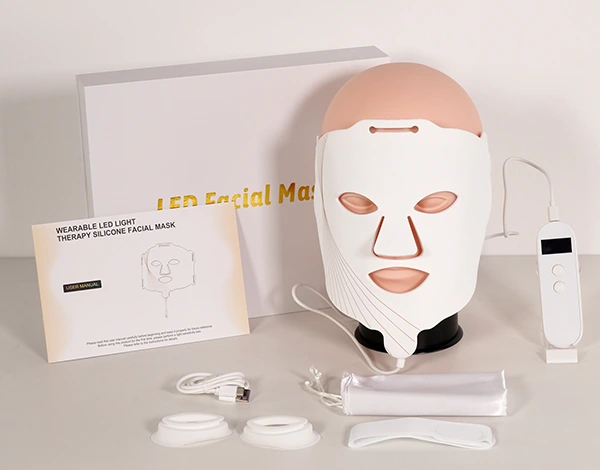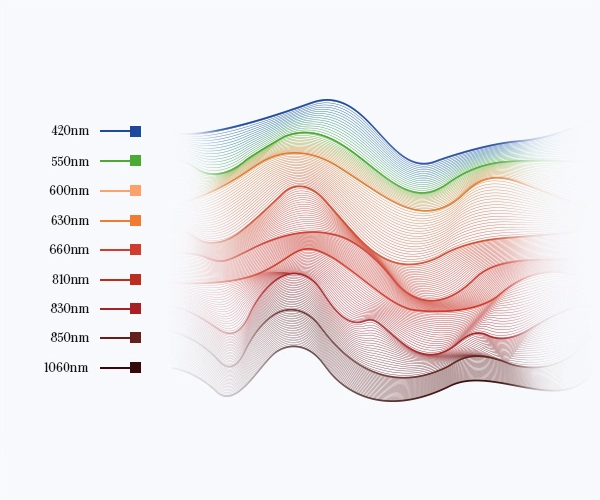Un guide à 6 points pour choisir un masque LEDPhérapie LED efficace et sûr
Le monde des soins de la peau avancés ne se limite plus aux cliniques de dermatologie. Les masques de thérapie LED à domicile ont augmenté en popularité, Offrir un outil non invasif pour le rajeunissement et le traitement de la peau directement dans le confort de votre maison. Ce passage de l’usage clinique à l’usage domestique, cependant, impose le fardeau du choix au consommateur. Comment pouvez-vous être sûr que l'appareil que vous’réinvestir dans est non seulement efficace mais aussi totalement sûr?
Ce guide fournit une explication claire, cadre fondé sur des preuves pour vous aider à évaluer les masques LED. En misant sur la sécurité, efficacité, et la convivialité, vous pouvez éviter le bruit du marketing et prendre une décision éclairée pour votre peau’la santé.
Au cours des dernières années, La luminothérapie LED est devenue un traitement de la peau non invasif et sûr populaire et un traitement anti-âge. Cependant, Beaucoup de gens remettent toujours en question son efficacité. Cet article résume les preuves de 30 Études expérimentales publiées au cours des cinq dernières années, soutenir l'efficacité de la lumière bleue, feu rouge, Lumière jaune et proche infrarouge (Nir) LED LIGHT dans le traitement de diverses affections cutanées et la promotion de la régénération cutanée.

1.Comprendre le principe fondamental: Photobiomodulation (PBM)
Qu'est-ce que c'est: Avant de pouvoir choisir un appareil, il’Il est essentiel de comprendre la science qui le fait fonctionner. La thérapie LED repose sur un processus appelé Photobiomodulation (PBM). Le PBM est un mécanisme scientifiquement validé dans lequel des, les longueurs d'onde non thermiques de la lumière sont absorbées par les structures cellulaires, notamment, les mitochondries. Cette absorption stimule la production d'Adénosine Triphosphate (ATP), la monnaie énergétique de vos cellules.
L'impact cellulaire: Cette augmentation de l’énergie cellulaire se traduit directement par des bienfaits clés pour la peau. Les cellules énergisées fonctionnent plus efficacement, conduisant à:
- Augmentation de la production de collagène et d'élastine: Cela aide à raffermir la peau et à réduire l’apparence des rides et ridules..
- Inflammation réduite: Cela calme les rougeurs, apaise l'irritation, et peut aider à gérer des maladies comme la rosacée et l'acné.
- Réparation cellulaire accélérée: Cela accélère la cicatrisation des plaies et des imperfections.
Ce n'est pas un lit de bronzage: Il est crucial de distinguer la lumière LED thérapeutique des ultraviolets nocifs. (UV) lumière. Les appareils de thérapie LED font pas émettre des rayons UV nocifs. Lorsque vous achetez un masque conforme et suivez les procédures d'utilisation appropriées, il n'y a aucun risque de lésions cutanées liées au bronzage ou à l'exposition au soleil.
2.Longueurs d'onde cliniquement prouvées et leurs avantages
La magie thérapeutique d'un masque LED réside dans ses longueurs d'onde spécifiques, qui sont mesurés en nanomètres (nm). La couleur est simplement une représentation visuelle; la mesure précise au nanomètre détermine l’effet biologique.
Les longueurs d’onde comptent plus que la couleur: Alors que de nombreux masques offrent un arc-en-ciel d'options, les preuves cliniques les plus solides soutiennent quelques longueurs d'onde clés:
- Feu rouge (~630 nm – 660nm): C'est la centrale anti-âge. La lumière rouge pénètre profondément dans la peau pour stimuler les fibroblastes, les cellules responsables de la production de collagène. Le résultat est une densité cutanée améliorée, ridules réduites, et une circulation améliorée pour un éclat sain.

- Lumière bleue (~415nm – 465nm): Cette longueur d'onde fonctionne plus près de la peau’surface. Son principal avantage est sa propriété antibactérienne, en particulier sa capacité à neutraliser Cutibactérie acnés, la bactérie principalement responsable de l’acné inflammatoire. Il aide également à réguler le sébum (huile) production, ce qui en fait un outil clé pour gérer les éruptions cutanées.
- Proche infrarouge (Nir) Lumière (~830 nm – 850nm): Invisible à l'œil nu, NIR est la longueur d'onde pénétrante la plus profonde. Il agit à un niveau plus profond pour réduire l’inflammation, améliorer la circulation, et accélère considérablement la peau’les processus de guérison. Il est souvent associé à la lumière rouge pour offrir des avantages complets en matière de lutte contre le vieillissement et de récupération..
- Lumière jaune/ambre (~570 nm – 600nm): Cette longueur d'onde est efficace pour réduire les rougeurs et la sensibilité et peut aider à rincer et à améliorer le flux lymphatique pour éliminer les toxines de la peau..
3.Prioriser la sécurité et la réglementation
Dans un marché non réglementé, la certification officielle est votre indicateur de sécurité le plus fiable.
Autorisation de la FDA / Marquage CE / TGA / Approbation MDL
Il s’agit de la référence la plus critique. Rechercher un officiel Autorisation FDA (pour les États-Unis) ou un CE Mark (pour l'Europe). Ces certifications indiquent que l'appareil a fait l'objet d'un examen rigoureux en matière de sécurité et peut être légalement commercialisé pour l'usage auquel il est destiné.. D'autres certifications respectées incluent TGA (Australie) et MDL (Canada). Un appareil sans ces informations d'identification n'a pas été vérifié par les organismes de réglementation.

Sécurité matérielle et électrique
L'appareil sera en contact direct avec votre visage, donc ses matériaux comptent. Assurez-vous que le masque est fabriqué à partir de matériaux sans danger pour le corps, comme le silicone de qualité médicale, pour prévenir les irritations cutanées. En outre, vérifier les certifications de sécurité électrique (Par exemple, ETL, Ul, CE) pour se protéger des risques électriques.
Vérifiez les masques LED de Wakelife qui sont FDA 510(k) effacé>>
4.Évaluer l’efficacité des spécifications techniques
Au-delà de la sécurité, un masque’les spécifications techniques déterminent son efficacité.
Irradiance (Densité de puissance)
C’est sans doute la mesure d’efficacité la plus importante. L'irradiance mesure la quantité d'énergie lumineuse, ou « dose, » livré à votre peau, exprimé en milliwatts par centimètre carré (MW/cm2). Pour un effet thérapeutique, un appareil doit délivrer une dose suffisante. Recherchez un masque dont l'irradiance se situe dans la plage cliniquement prouvée., qui se situe généralement entre 30-100 MW/cm2. Soyez très sceptique envers les marques qui ne divulguent pas ce numéro; cela signifie souvent que la puissance de sortie est trop faible pour être efficace.
Précision de la longueur d'onde
Les marques réputées seront transparentes sur leur technologie. Des termes vagues comme « feu rouge » ne suffisent pas. Recherchez les spécifications indiquant les longueurs d'onde précises en nanomètres. (Par exemple, 633nm, 830nm). Cette précision garantit que vous recevez les ondes lumineuses exactes soutenues par la recherche clinique.
5. Évaluer le confort et la convivialité
Si un masque est inconfortable, tu as gagné’je ne l'utilise pas régulièrement, et la cohérence est primordiale.
- Matériau et ajustement:
- Matériaux recommandés: Optez pour des masques en flexible, silicone de qualité médicale ou résine polymère souple. Ces matériaux sont hygiéniques, facile à nettoyer, et épousez étroitement les contours uniques de votre visage.
- Le confort est la clé: Rigide, les masques en plastique à coque dure sont souvent inconfortables. Ils peuvent créer des points de pression douloureux et laisser des espaces entre le masque et votre peau, conduisant à une répartition inégale et inefficace de la lumière. Une conception flexible garantit un traitement confortable et efficace pour toutes les formes de visage.

- Caractéristiques ergonomiques:
- Conception légère: Le masque doit être suffisamment léger pour que vous puissiez le porter pendant 10-20 minutes sans ressentir de tension au cou.
- Bretelles réglables: Recherchez sécurisé, sangles faciles à régler qui offrent un ajustement personnalisé pour différentes tailles de tête, s'assurer que le masque reste confortablement en place.
- Sécurité et hygiène intégrées:
- Protection oculaire intégrée: Une lumière LED intense peut être nocive pour les yeux. Un masque de qualité doit avoir une protection oculaire dédiée, tels que des œilletons en silicone intégrés, qui bloquent complètement la lumière et assurent votre sécurité pendant le traitement. Les lunettes simples sont souvent insuffisantes et encombrantes.
- Facilité de nettoyage: Le matériau de la surface doit être non poreux et facile à nettoyer après chaque utilisation.. Certains matériaux haut de gamme présentent également des propriétés antimicrobiennes pour maintenir une hygiène optimale.
6. Établir des protocoles d'utilisation appropriée et gérer les attentes
La thérapie LED est un marathon, pas un sprint. Comprendre comment utiliser votre appareil et à quoi s'attendre est crucial pour réussir.
- La cohérence est la clé: Les résultats sont cumulatifs et dépendent de la cohérence, utilisation à long terme. Une seule séance offrira un éclat temporaire, mais des changements structurels durables nécessitent du dévouement.
- Directives générales d'utilisation: Un protocole typique est 3-5 fois par semaine pour 10-20 minutes par séance. Utilisez toujours le masque sur des surfaces propres, sécher la peau avant d'appliquer des sérums ou des crèmes hydratantes pour assurer une pénétration maximale de la lumière. Suivez votre séance avec votre routine de soin habituelle.
- Des délais réalistes: Gérez vos attentes.
- Acné: Des améliorations peuvent souvent être constatées au bout de quelques semaines d’utilisation régulière.
- Anti-âge: Les effets tels que la réduction des rides et l’amélioration de la fermeté mettent plusieurs mois à se manifester, car votre corps a besoin de temps pour produire du nouveau collagène..
- Contre-indications: La thérapie LED est sans danger pour la plupart des gens, mais certaines personnes devraient l'éviter ou consulter d'abord un médecin. Cela inclut ceux qui:
- Sont enceintes.
- avez des antécédents de convulsions ou d’épilepsie.
- Prenez des médicaments photosensibilisants (Par exemple, certains antibiotiques, Accutane).
- avez des antécédents de problèmes de santé déclenchés par la lumière.

